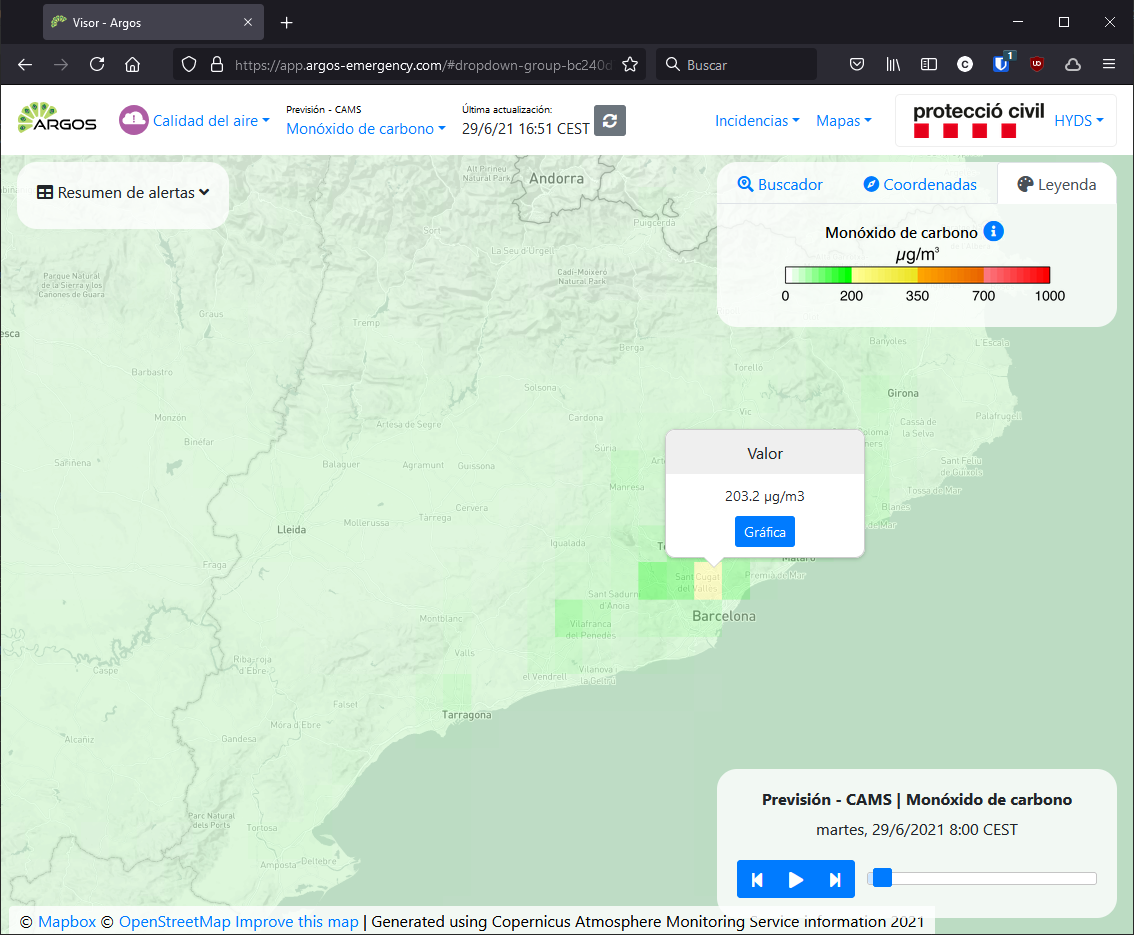CAMS air quality forecasts#
The air quality forecasts provided by Copernicus Atmosphere Monitoring Service (CAMS) are based on a set of 9 state-of-the-art numerical air quality models developed in Europe:
CHIMERE from INERIS (France)
EMEP from MET Norway (Norway)
EURAD-IM from Jülich IEK (Germany)
LOTOS-EUROS of KNMI and TNO (Netherlands)
MATCH of SMHI (Sweden)
MOCAGE of METEO-FRANCE (France)
SILAM of FMI (Finland)
DEHM of AARHUS UNIVERSITY (Denmark)
GEM-AQ of IEP-NRI (Poland)
The regional air quality models provide daily 4-day forecasts of major air pollutant concentrations in the lower atmosphere for the European domain. Their horizontal coverage is 0.1° (approximately 10-20 km), which allows tracking and forecasting of background air pollution levels and mid-range atmospheric composition.
Temporal and spatial resolution#
The forecast provides data for the next 4 days with a 1 hour time step.
The spatial resolution is 0.1º x 0.1º lat/long.
Update frequency#
The data is updated once a day following the model run:
00h UTC (Official summer time: 02h CEST. Official winter time: 01h CET).
Available variables#
The following variables are available on the platform
Carbon monoxide#
Carbon monoxide (CO) is an air pollutant produced by the burning of fossil fuels, as well as by forest fires and biomass burning. It has a half-life of several months and therefore clearly shows long-range transport.
The units used are µg/m3.
Nitrogen dioxide#
Nitrogen dioxide (NO2) is a toxic, irritant gas and a precursor for the formation of nitrate particles.
It mainly affects the respiratory system as breathing air with a high concentration of NO2 can irritate the human respiratory tract. Short-term exposures can aggravate respiratory diseases, in particular asthma, leading to respiratory symptoms (such as coughing, wheezing or shortness of breath), hospital admissions and emergency room visits. Longer exposures to high concentrations of NO2 can contribute to the development of asthma and potentially increase susceptibility to respiratory infections. People with asthma, as well as children and the elderly, are generally at increased risk from the health effects of NO2.
In addition, nitrogen dioxide is one of the gases responsible for acid rain, as it dissolves in water to form nitric acid.
The units used are µg/m3.
Sulphur dioxide#
Sulphur dioxide (SO2) is a colourless gas with a characteristic irritating odour. It is also the main cause of acid rain as it is transformed into sulphuric acid in the atmosphere.
It is released in many combustion processes as fuels such as coal, oil, diesel or natural gas contain certain amounts of sulphur compounds.
The units used are µg/m3.
Ozone#
Ozone (O3) is a colourless, highly reactive gas found in all layers of our atmosphere. Most ozone (about 90%) is found in the stratosphere, which begins about 10-16 kilometres above the Earth’s surface and extends to a height of about 50 kilometres. Stratospheric ozone protects life on Earth from harmful ultraviolet (UV) radiation, and is therefore often referred to as “good” ozone. This contrasts with ozone in the troposphere, the lowest layer of the atmosphere, where it is an air pollutant and can be harmful to humans, animals and vegetation.
The units used are µg/m3.
Particulate matter < 10µm#
PM10 is small solid or liquid particles of dust, ash, soot, metal particles, cement or pollen, dispersed in the atmosphere, whose aerodynamic diameter is less than 10 µm (1 micrometre corresponds to one thousandth of 1 millimetre). They are mainly composed of inorganic compounds such as silicates and aluminates, heavy metals, among others, and organic material associated with carbon particles (soot).
PM10 can irritate the nose and throat tissue, causing allergic reactions.
The units used are µg/m3.
Particulate Matter < 2.5µm#
Particulate matter PM2.5 are very small particles suspended in the air that have a diameter of less than 2.5 microns. Particulate matter includes organic chemicals, dust, soot and metals.
Unlike PM10, PM2.5 can not only enter the lungs, but also permeate the bloodstream and other parts of your body such as the brain.
The units used are µg/m3.
Visualization#

Useful links#
Copernicus Atmosphere Monitoring Service (CAMS)
Data sources#
Data provided by Copernicus Atmosphere Monitoring Service (CAMS) via the Atmosphere Data Store (ADS) are used.